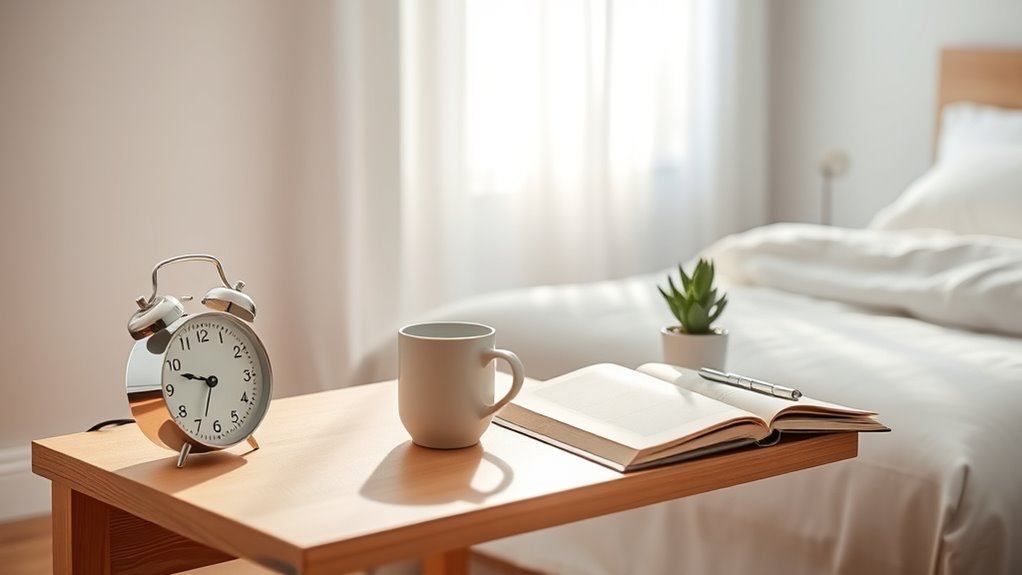To design a minimalist morning routine that sticks, start by selecting a few simple, core activities like stretching, hydrating, and practicing a brief moment of meditation. Keep your routine short and consistent by setting a fixed wake-up time and allocating specific time slots for each step. Focus on repetition and celebrate your progress to build habits naturally. By maintaining simplicity and clarity, you’ll create a sustainable routine that sets a positive tone for your whole day—learn how to refine it further through this guide.
Key Takeaways
- Keep the routine simple by focusing on 2-3 core activities that energize and prepare you for the day.
- Set a fixed wake-up time and allocate specific durations for each activity to build consistency.
- Perform the routine at the same time daily, including weekends, to reinforce automatic habits.
- Use reminders or alarms to prompt adherence and celebrate small wins to stay motivated.
- Incorporate mindfulness, stretching, or hydration to enhance mental clarity and overall well-being.

Creating a minimalist morning routine can set a focused tone for your entire day. When you streamline your mornings, you free up mental space and reduce decision fatigue, allowing you to approach the day with clarity. To make this routine stick, you need to pay close attention to how you manage your time and how you form habits. Establishing a simple, repeatable sequence helps you gain control over your mornings rather than feeling like they control you.
Start by identifying the core activities that truly benefit you. Think about what energizes you, what sets a positive tone, or what helps you feel prepared. Keep these activities minimal—perhaps a quick stretch, a glass of water, or a brief meditation. The goal is to create a routine that’s easy to follow without overwhelming yourself. When you focus on just a few essential actions, you’re more likely to develop consistency because there’s less friction and fewer decisions to make each morning.
Time management plays a pivotal role in designing your routine. Allocate specific time blocks for each activity and honor them. Setting a fixed wake-up time anchors your morning and helps establish a natural rhythm. Using alarms or reminders can reinforce this consistency. When you assign each task a clear time slot, you avoid wasting precious minutes debating what to do next, which keeps your mornings flowing smoothly. Over time, this punctuality becomes a habit—something your brain automatically expects and performs without extra effort.
Habit formation is key to making a minimalist routine stick. Repetition is what transforms small actions into automatic behaviors. To reinforce this, perform your routine at the same time every day, even on weekends. Celebrate small wins, such as successfully waking up on time or completing your chosen activities without distraction. These successes create positive associations that strengthen your commitment. Keep it simple and avoid adding unnecessary steps; complexity can sabotage your efforts by making the routine harder to maintain. Remember, the goal is consistency, not perfection. If you miss a step occasionally, don’t get discouraged—simply return to your routine the next day.
Additionally, incorporating well-being techniques like mindfulness or gentle stretching can enhance your morning experience and support mental clarity. Over time, your minimalist morning routine will become a seamless part of your day. When you prioritize quality over quantity and focus on building habits around a few meaningful actions, you create a sustainable pattern. This approach not only improves your mornings but also boosts your overall productivity and mental clarity. By managing your time wisely and reinforcing habits, you set yourself up for success, starting each day with intention and focus.
Frequently Asked Questions
How Long Should a Minimalist Morning Routine Ideally Last?
The ideal duration of your minimalist morning routine balances enough time to energize you without causing burnout. Typically, 10 to 30 minutes works well, offering enough flexibility to adapt as your needs change. Keep it simple, focusing on key activities that boost your mood and productivity. This duration allows routine flexibility, so you stay consistent without feeling overwhelmed, helping your new habits stick long-term.
Can a Minimalist Routine Accommodate Spontaneous Activities?
A minimalist routine can definitely accommodate spontaneous activities by allowing flexibility in planning. You can set a simple structure, like a few core tasks, while leaving space for surprises or last-minute plans. This balance helps you stay consistent without feeling restricted. By intentionally designing your routine to be adaptable, you create room for spontaneity, making your mornings more enjoyable and sustainable.
What Are Common Pitfalls When Establishing a Routine?
When establishing a routine, you often face habit formation and consistency challenges. Common pitfalls include setting unrealistic expectations, which can lead to frustration and giving up. You might also neglect flexibility, making it harder to adapt to spontaneous activities. To succeed, focus on small, manageable changes, stay consistent, and give yourself grace during setbacks. Overcoming these pitfalls helps you build a sustainable, minimalist morning routine that sticks.
How Do I Adjust My Routine During Busy Days?
Think of your routine as a sailboat steering unpredictable waters. When busy days hit, you adjust your sails with flexibility strategies, not by abandoning the course. Prioritize essential tasks, streamline your morning, and trust your time management skills to adapt smoothly. Embrace these small shifts, knowing they keep your journey steady, even when the seas get rough. Flexibility ensures you stay on course, no matter the turbulence.
Is It Necessary to Wake up Early for a Minimalist Routine?
You don’t need to wake up early for a minimalist routine. Prioritize sleep consistency to feel energized, and prepare your morning the night before with simple tasks. Waking up later can still set a calm, intentional tone for your day if you focus on quality sleep and efficient evening preparation. The key is to tailor your routine to your lifestyle, ensuring it’s sustainable and stress-free.
Conclusion
Think of your minimalist morning routine as a well-tended garden. With only a few intentional plants—your essential habits—you create a space that’s easy to nurture and enjoy. Keep it simple, remove the weeds of unnecessary tasks, and watch your mornings flourish. When you focus on what truly matters, your routine becomes a peaceful sunrise, setting a calm, purposeful tone for the day ahead. Cultivate this habit, and mornings will bloom effortlessly.









